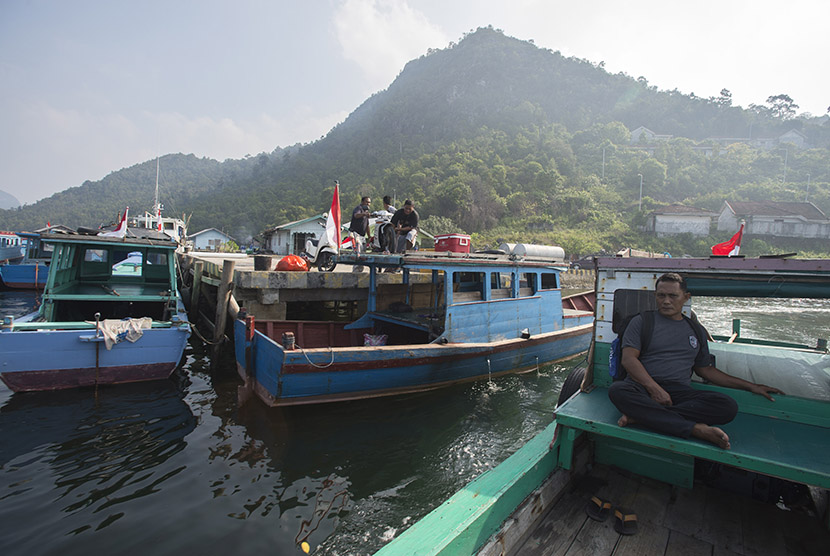REPUBLIKA.CO.ID, By: Azhari Setiawan *)
Indonesia finally ‘came into the Ring of South China Sea’. The act of Chinese coast guard vessel boat entering Indonesia territory to “interfere” Indonesia’s national security operation, especially when fisheries ministry arrested alleged fish theft, has gained the tensions in South China Sea dispute.
Tensions spiked in the South China Sea on Sunday due to an incident involving a Chinese fishing boat in the Natuna Sea, near Indonesia’s Natuna Islands. The Jakarta Post stated that, Chinese coast guard vessels “forcibly rescued” a Chinese fishing boat, the Kway Fey 10078, after it had been interdicted and captured by Indonesia’s Maritime and Fisheries Monitoring Task Force. The vessel was pursued by Indonesian authorities because it was fishing illegally near the Natuna Islands. According to Indonesia’s Minister of Fisheries and Maritime Affairs Susi Pudjiastuti statement, Kway Fey 10078 was within 4.34 kilometers off one of the Natuna Islands, but it remains ambiguous if this is where the vessel was initially spotted fishing by Indonesia authorities or if this was the location of the Chinese coast guard’s so-called forcible rescue.
The Chinese demanded back to Indonesia, noted that the fishing vessel was engaged in “traditional Chinese fishing grounds” as “normal activities”. Indonesia should concern to this statement because this statement could be a reason for China may be asserting maritime claims to waters in the Natuna Sea regarding to China’s policy presented new maps of its nine-dashed line claim that included waters in the Natuna Sea. Indonesia has also moved to bolster its defense near the Natuna Islands.
Indonesia has summoned the Chinese ambassador in Jakarta over the incident. At least, there are three main points to consider and concern about if our ministry of foreign affairs really serious to present protest notes toward China’s government.
First, What China called as “traditional fishing grounds” is “nonsense” at all. Traditional fishing ground is not a ‘unilateral’ policy according to UNCLOS 1982 Article 51 stated:
“Without prejudice to article 49, an archipelagic State shall respect existing agreements with other States and shall recognize traditional fishing rights and other legitimate activities of the immediately adjacent neighbouring States in certain areas falling within archipelagic waters. The terms and conditions for the exercise of such rights and activities, including the nature, the extent and the areas to which they apply, shall, at the request of any of the States concerned, be regulated by bilateral agreements between them. Such rights shall not be transferred to or shared with third States or their nationals”
Based on this UNCLOS 1982 Article 51, China has no business with ‘traditional fishing rights’ upon Indonesia’s sea in Natuna and all of other jurisdiction maritime areas. Since nine-dashed lines claim and even before, there is no any agreement about traditional fishing right between China and Indonesia. So, traditional fishing right is not merely inherent to any fishing activities in/of an archipelagic state. It requires a clear requirement and bilateral agreement which become legitimate rule. Anyway, if China really means it—traditional fishing right—why was there a coast guard vessel? If China really means the traditional fishing right, why was so insecure using the coast guard?
Second, if Indonesia wants to use a map in the protest, Indonesia must not present the nine-dashed lines map of China. Because if nine-dashed lines was attached, it means that Indonesia acknowledge China’s claims. If Indonesia acknowledge China’s claim, it could justify China’s traditional fishing grounds claim and also would cause other tensions from other claimant states. So the map must highlight and assert the Natuna point of incident only. Also, the protest should demand China to recognize and respect not only Natuna’s area, but also all of jurisdictions of Indonesia’s maritime territories including our Exclusive Economic Zone and Continental Shelf (200 NM up to 350 NM from Territorial Zone based on UNCLOS 1982).
Third, the protest note agenda is not to demand our ‘sovereignty’ rights, but to demand our ‘sovereign’ rights. This is because the incident occurred in our Exclusive Economic Zone not in our Territorial Zone. Based on the Law of The Sea, China has interrupt Indonesia’s sovereign right because China has ‘trespassed/infringed’ Indonesia’s Exclusive Economic Zone by its illegal fishing activities. If we use ‘sovereignty’ term, the problem is on our Territorial Zone and China has nothing to do with it, even China could send back a protests note regarding to our allegation. We don’t want a simple technical flaw weaken our bargaining position toward China.
These three points of statement will corroborate and strengthen Indonesia’s position toward South China Sea dispute. Indonesia may be not a claimant state and also recognizes and respects all of the claims from all claimants including China itself, but Indonesia also has sovereign rights to be recognized and respected. Indonesia has 200 NM of Exclusive Economic Zone and up to 350 NM of Continental Shelf to be respected by all countries. This issue also obligates our government to maximize its defense system, focus it to the maritime with serious concern, and increase our military defense deployment on every single maritime point including the EEZ and Continental Shelf. This is a defining moment, an opportunity for Indonesia to get its “maritime axis power” back.
*) Postgraduate Program of International Relations Department, University of Indonesia, Forum for Academician of International Relations (FAIR), Universitas Riau


